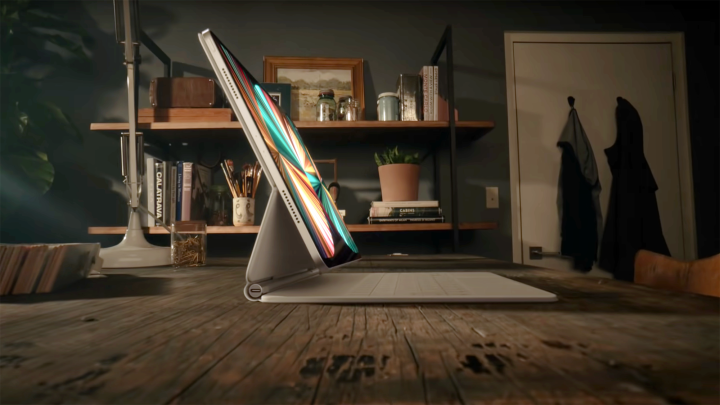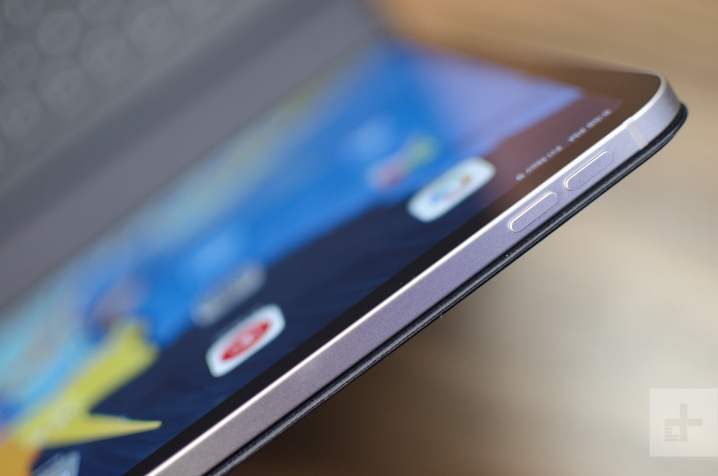If you’re looking for a tablet that can double as a laptop, the two best options right now are Apple’s iPad Pro and Microsoft’s Surface Pro X. Both devices feature super-slim bezels and support optional pen and keyboard accessories.
Microsoft’s Surface Pro X is the older of the two devices, though you might be wondering how it stands up to the latest iPad Pro, now equipped with Apple’s M1 chip. In this guide, we’ll compare design, performance, and portability to help you choose the right one for you.
Design

In terms of design, both the iPad Pro and the Surface Pro X are super slim and pack a large, immersive display. There are some notable differences, however.
First, the bezels on the iPad Pro are much slimmer and consistent all the way around. The bezels on the Surface Pro X are similarly narrow on the sides, but the top and bottom borders are thicker.
As for the display itself, both devices have high-resolution screens. The Surface Pro X comes with a 2880 x 1920 (267 ppi) resolution while the 12.9-inch iPad Pro has a 2732 x 2048 (264 ppi) resolution. The Surface Pro X also sports a 3:2 aspect ratio, whereas the iPad Pro sits at 4:3. That makes the Surface Pro X a better option for productivity, while the iPad Pro feels a bit more square, making for a nicer tablet experience.
The Pro X also has slightly more pixels per inch than the iPad, but the 11-inch iPad Pro sports a brighter 600 nit 120Hz True Tone display, which we found makes scrolling smoother and more responsive. The mini-LED display on the 12.9-inch model is even brighter at 1000 nits max brightness. The Surface Pro X is slightly behind the 11-inch iPad Pro with a dimmer 450 nit 60Hz panel, which is common for most Windows devices.
Importantly, the Surface Pro X benefits from the built-in kickstand, making the device easier to use on a flat surface (no pun intended).

Next, there’s connectivity, which is also different between the two tablets. On the iPad Pro, there is a single Thunderbolt/USB-4 port, a magnetic smart connector port, and a nano-SIM slot. There is also a magnetic strip at the top to hold and charge the Apple Pencil, sold separately.
The Surface Pro X, meanwhile, doubles that up. It features two USB-C ports, a nano-SIM slot, and Microsoft’s proprietary Surface Connect port for charging. You’ll also find the connector for the keyboard on the long button-free edge. Both devices lack a headphone jack, which means you’ll need to buy a dongle or use a pair of
Finally, both devices sport an option for a keyboard cover. Apple’s new Magic Keyboard is based on scissor switches and starts at a hefty $299. It includes a built-in trackpad, a USB-C port for pass-through charging, and a unique hinge that “floats” the tablet and angles it back for optimal viewing. There are also now two colors for the Magic Keyboard: white and black. The cheaper Smart Keyboard Folio doesn’t include a trackpad.
The Surface Pro X, meanwhile, supports an optional $140 Type Cover. In terms of comfort, we found it was essentially the same as what we experienced with the Surface Pro 6, but it now also houses a special spot in the top for the Surface Pen — which we’ll discuss later. However, note the Pro X does not support older Microsoft Type Covers, as the connector is different.
Microsoft also sells a “signature” version of the keyboard bundled with the Slim Pen for $270. This keyboard features an Alcantara-covered surface, whereas the standard model does not.
Apple’s iPadOS has evolved to offer a better software solution for multitasking and productivity than it has in the past, but the full version of Windows 10 on the Surface Pro X will be more familiar to most Windows PC owners.
Ultimately, the iPad Pro is the better tablet, but the Surface Pro X is the better laptop replacement.
Performance

Unlike previous Intel-based devices, Microsoft partnered with Qualcomm to co-create two all-in-one processors dubbed as the SQ1 and SQ2. They’re based on Qualcomm’s Snapdragon 8cx 1st- and 2nd-gen chips. They’re also technically a System-on-a-Chip, or SoC, which includes not only processor and graphics cores, but other components like the modem.
Both custom Microsoft chips rely on ARM’s big.LITTLE design. For example, the SQ1 has four “performance” CPU cores clocked at 3GHz and four “power-efficient” CPU cores clocked at 1.8GHz. One batch handles the heavy loads (gaming) and one handles the lite tasks (web browsing). According to Microsoft, the SQ1 features three times more performance per watt than the Surface Pro 6’s Intel 8th-gen chip.
Likewise, the beefier SQ2 has four “big” CPU cores at 3.15GHz and four “little” CPU cores at 2.42GHz. This chip didn’t appear in the Surface Pro X until October 2020.
However, there are some limitations to take note of, as some areas of Windows 10 and 64-bit apps aren’t optimized for ARM-based chipsets. It should still be great for web browsing and other day-to-day activities while other apps like Photoshop might not work quite as well.

The latest iPad Pro, meanwhile, sports Apple’s custom ARM-based M1 processor, the same one found in the latest Macs. Take a look at their Geekbench scores and you can see how all three chips stack up against each other. What you’ll find is that Apple’s chip out-performs Microsoft’s two new custom chips by a large margin:
| SQ1 | SQ2 | Apple M1 | |
| Single-core | 747 | 779 | 1712 |
| Multi-core | 2958 | 3045 | 7207 |
This means that no matter what you download from the App Store, the iPad Pro will run it at breakneck speeds. However, the iPad Pro is limited to apps in the App Store, as it is powered by iPadOS. The Pro X, meanwhile, runs full Windows 10 and is compatible with traditional desktop programs, although you are limited to 32-bit apps.
Portability

In terms of portability, the Surface Pro X and the iPad Pro are almost neck and neck. Here’s a chart to compare all three:
| Surface Pro X | iPad Pro 12.9 | iPad Pro 11 | |
| Height ( in inches) | 11.3 | 11.04 | 9.74 |
| Width (in inches) | 8.2 | 8.46 | 7.02 |
| Depth (in inches) | 0.28 | 0.25 | 0.23 |
| Weight (in pounds) | 1.706 | 1.5 | 1.03 |
Of the three, the 11-inch iPad Pro is the lightest, but when comparing the two bigger tablets, the iPad Pro is both the lightest and thinnest. The Surface Pro X is taller and narrower than the larger iPad.
As for battery life, Apple promises up to 10 hours on the iPad Pro, though we were able to push our iPad Pro through several days with a few hours of usage at a time. The iPad Pro also supports fast charging with the optional 30-watt USB-C Power Adapter.
Microsoft promises up to 13 hours of battery life on the Surface Pro X with the screen at 150 nits of brightness. However, judging the fact that the Pro X is an always-connected PC — which we’ve seen get up to 13 hours of battery — it may prove correct. It also supports fast charging via the Surface Connect port. Microsoft claims that this can get you to an 80% charge in just one hour.

We’ll also mention the support for LTE on both devices. All models of the Surface Pro X have a nano-SIM tray. That means you get LTE connectivity with any configuration, whereas with the iPad Pro, you need to pay $150 extra if you want a model with LTE.
Finally, there is the pen. Microsoft’s Surface Slim Pen slots right into the Type Cover keyboard and recharges wirelessly. This makes it easy for portability, but it’s also a separate $145 purchase. That’s significantly more than the $129 Apple Pencil, which also charges wirelessly when it’s magnetically attached to the top of the iPad Pro — no keyboard accessory required.
The iPad Pro keeps the crown

The Surface Pro X and iPad Pro are similar in many ways, but we think most people will be happier with Apple’s offering.
The base 11-inch iPad Pro (with 128GB of storage and without the LTE option) comes at a starting price of $749, which rises to $1,999 when you add the maximum 2TB of storage space and LTE. If you’re someone who prefers the bigger 12.9-inch model, you can expect to pay a starting cost that ranges from $999 to $2,299. It’s worth mentioning that you’ll need to add on an extra $129 for the Apple Pencil and approximately $179 and $299 (base rates) for the Smart Keyboard Folio and the Smart Keyboard, sequentially.
When it comes to the Surface Pro X, the base price is $999 for the SQ1 chip, 8GB of RAM, and 128GB of storage space. However, the rate skyrockets up to $1,217 when you combine it with the keyboard and pen (when you buy them as a bundle). Yes, you’ll get a lot more storage space in the first model than the equivalent iPad Pro, but you also must examine if its ARM-based processor will be harmonious with the apps you want to use regularly.
Conclusively, the iPad Pro is the prime choice at this point. Even if you are used to working with Windows, you’ll discover many of the same apps included in Apple’s App Store. If you’re someone who’s looking to use conventional desktop software, we feel Microsoft’s Surface Pro X will be better suited for you.
Editors' Recommendations
- Best iPad deals: Save on iPad Air, iPad Pro, iPad Mini for the New Year
- Surface Laptop Go 3 vs. Surface Pro 7+: is it an upgrade?
- This tiny ThinkPad can’t quite keep up with the MacBook Air M2
- Have an iPhone, iPad, or Apple Watch? You need to update it right now
- Why the latest ThinkPad X1 Yoga Gen 8 isn’t worth the upgrade


